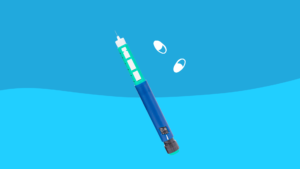Understanding Symptoms and Causes of Diabetes Insipidus: A Comprehensive Guide
HOME | DIABETES EDUCATION | DIABETES INSPIDUS SYMPTOMS, CAUSES AND TREATMENT
Are you feeling constantly thirsty and urinating more than usual? You may be suffering from diabetes insipidus, a rare condition characterized by excessive thirst and increased urination. Don’t worry – with the right knowledge, you can understand and manage your condition. In this article, we’ll discuss the symptoms and causes of diabetes insipidus, plus associated procedures and products and services.
Key Takeaways
- Diabetes insipidus is a rare condition characterized by excessive thirst and increased urine production.
- There are three main types of diabetes insipidus: central, nephrogenic, and pregnancy-related.
- Diabetes insipidus is caused by a deficiency in the hormone vasopressin, which is responsible for regulating water balance in the body.
- Symptoms of diabetes insipidus include unquenchable thirst, increased urine production, and colorless, odorless urine.
Types of Diabetes Insipidus
Diabetes insipidus has three types: central, nephrogenic, and pregnancy-related. Central diabetes insipidus is caused by a lack of vasopressin due to damage to the hypothalamus or pituitary gland. Nephrogenic diabetes insipidus occurs when the kidneys don’t respond properly to vasopressin. Gestational diabetes insipidus happens during pregnancy when placental enzymes destroy vasopressin.
Primary polydipsia or dipsogenic diabetes insipidus is associated with damage to the thirst-regulating mechanism in the hypothalamus or mental illness. Symptoms include excessive thirst, producing large amounts of pale urine, frequent nighttime urination, and daily urine output of 1 to 3 quarts. If you have these symptoms, seek medical attention promptly.
Excessive Thirst as a Symptom
Excessive thirst is a main symptom of diabetes insipidus. It can be caused by damage to the thirst-regulating mechanism in the hypothalamus or mental illness. People with this disorder constantly feel thirsty and drink a lot of fluids. Other symptoms include producing large amounts of pale urine, frequent urination, and drinking during the night. Dehydration can also be a side effect. If you or someone you know experiences these symptoms, seek medical attention. Monitoring the amount of urine passed can indicate the severity of the condition.
Increased Urine Production
Diabetes insipidus leads to increased urine production and excessive thirst. The amount of urine produced can be much higher than normal, up to 20 quarts a day. This condition occurs due to damage to the hypothalamus or pituitary gland, resulting in a deficiency in the hormone vasopressin, which regulates urine production.
The normal range for 24-hour urine volume is 800 to 2,000 milliliters per day (with a normal fluid intake of about 2 liters per day).
It can also be caused by certain medications, electrolyte imbalances, urinary tract issues, or chronic kidney conditions. Other symptoms include unquenchable thirst, colorless urine, wet diapers in babies, bed-wetting, weight loss, poor growth, vomiting, irritability, fever, constipation, headache, sleep problems, and vision problems. If you experience any of these symptoms, seek medical attention to determine if diabetes insipidus is the cause.
Central Diabetes Insipidus Causes
Central diabetes insipidus is diagnosed when there is damage to the hypothalamus or pituitary gland, autoimmune reactions, or inherited disorders. It is caused by a deficiency in the hormone vasopressin, which leads to an inability to balance fluids, excessive thirst, and increased urine production. Nephrogenic diabetes insipidus, on the other hand, occurs when the kidneys do not respond to vasopressin, resulting in the inability to retain water and excessive urine production. Causes include damage from surgery, tumor, head injury, illness, or autoimmune reaction, as well as kidney problems, certain medications, low potassium levels, high calcium levels, urinary tract issues, or chronic kidney conditions. Seek medical attention if you experience increased urination and excessive thirst.
Nephrogenic Diabetes Insipidus Causes
Nephrogenic diabetes insipidus can be caused by various factors such as hereditary conditions, chronic lithium ingestion, and hypercalcemia. It occurs when the body cannot properly process vasopressin, a hormone that helps regulate urine and fluid levels in the kidneys. Symptoms include excessive thirst, frequent urination, and pale urine. Treatment options may involve adjusting medications, administering intravenous fluids, and hormone replacement therapy. If you experience these symptoms, it is important to seek medical help for diagnosis and appropriate treatment.
Gestational Diabetes Insipidus Causes
Gestational diabetes insipidus during pregnancy is caused by excessive vasopressinase activity, an enzyme produced by placental trophoblasts. This type of diabetes insipidus typically occurs in the third trimester and may be more common in multiple pregnancies or those with larger placentas. Symptoms include excessive thirst, frequent urination, and pale urine. Specific causes of gestational diabetes insipidus include liver dysfunction, such as acute fatty liver of pregnancy, HELLP syndrome, hepatitis, and cirrhosis, which can increase vasopressinase concentrations. Treatment options include desmopressin, monitoring vital signs, and evaluating fluid balance and fetal status. If you experience symptoms of diabetes insipidus while pregnant, consult your doctor for diagnosis and treatment.
Primary Polydipsia as a Cause
Primary polydipsia can cause diabetes insipidus. It is characterized by constant thirst and excessive fluid intake due to damage to the thirst-regulating mechanism in the hypothalamus or mental illness. People with primary polydipsia produce more urine than normal because the body cannot produce enough vasopressin. This leads to excessive thirst, large amounts of pale urine, frequent urination, and drinking during the night. If you experience these symptoms, seek medical attention for a possible diagnosis of diabetes insipidus. Your doctor may recommend genetic testing, MRI, or urinalysis for diagnosis. Treatment may involve medications to increase ADH or surgery to remove the cause of the disorder.
Risk Factors for Developing Diabetes Insipidus
Having a family history of diabetes insipidus increases your risk of developing the condition. Other risk factors include brain surgery, major head injury, certain medications, and metabolic disorders like high blood calcium or low blood potassium levels. Diabetes insipidus is caused by a lack of antidiuretic hormone (ADH), which is produced by the pituitary gland in the brain. When the body loses too much fluid, insufficient ADH production leads to the condition. Seek medical attention if you or your family members experience excessive thirst and frequent urination, as untreated diabetes insipidus can result in serious health complications.
Diagnosis of Diabetes Insipidus
To diagnose diabetes insipidus, see your healthcare provider if you have frequent urination and excessive thirst. Diagnosis involves a physical exam, medical history assessment, urinalysis, blood tests, fluid deprivation tests, and sometimes MRI scans. Central diabetes insipidus is caused by pituitary gland or hypothalamus damage, while nephrogenic diabetes insipidus is caused by kidney problems, medications, or electrolyte imbalances. Urine tests check for excessive water content, while blood tests measure sodium, potassium, and calcium levels to aid in diagnosis and determine the type of diabetes insipidus. The diagnosis process includes a water deprivation test, manufactured ADH test, and MRI scan to identify abnormalities in the pituitary gland or hypothalamus.
Complications of Diabetes Insipidus
Dehydration and electrolyte imbalance are the main complications of diabetes insipidus. If not treated or managed well, diabetes insipidus can lead to dehydration, electrolyte imbalance, and other health issues. Dehydration occurs when it’s difficult to retain enough water, even with constant fluid intake. Symptoms of dehydration include dizziness, headache, dry mouth, confusion, irritability, and sunken eyes. Electrolyte imbalance happens when the body loses too much water, causing an increase in electrolyte concentration like sodium, potassium, and magnesium. Symptoms of electrolyte imbalance include headache, fatigue, irritability, and muscle pain. To prevent complications, it’s important to recognize diabetes insipidus symptoms, manage fluid intake and output, follow a balanced diet, stay hydrated, and regularly visit a healthcare provider. Educating oneself about diabetes insipidus and its complications is also crucial for prevention.
Management and Treatment Options
Consider management and treatment options for diabetes insipidus. Treatments include addressing the underlying cause, managing symptoms, and avoiding dehydration. Replace the missing hormone, vasopressin, with medications like desmopressin. Increase water intake to maintain fluid balance. Treat underlying conditions, such as tumors or head injuries, to reduce symptoms. Seek medical advice if experiencing symptoms. Doctors can use tests to measure changes in body weight, urine production, and hormone levels. Treatment options depend on the type of diabetes insipidus. Clinical trials are available for new treatments. Follow healthcare provider instructions and carry water and medication to prevent dehydration. Wear a medical alert bracelet for emergencies.
Difference Between Diabetes Insipidus and Diabetes Mellitus
Diabetes insipidus and diabetes mellitus have different causes and symptoms. Diabetes insipidus is a rare condition caused by a deficiency or overproduction of the hormone vasopressin. There are three types: central, nephrogenic, and gestational. Central diabetes insipidus results from a lack of vasopressin, while nephrogenic diabetes insipidus is caused by the kidneys’ inability to respond to the hormone. Gestational diabetes insipidus occurs during pregnancy when the placenta destroys vasopressin. On the other hand, diabetes mellitus is more common and occurs when the body can’t use energy from food properly. Symptoms of diabetes insipidus include constant thirst, excessive urine production, and colorless, odorless urine. Diabetes mellitus symptoms include excessive thirst, increased urination, and fatigue. Treatment for diabetes insipidus involves replacing vasopressin, while diabetes mellitus is managed through medications, insulin shots, and lifestyle changes.
Impact of Diabetes Insipidus on Babies and Children
Diabetes insipidus in babies and children has three types: Central, Nephrogenic, and Gestational. Central diabetes insipidus is caused by a deficiency in the hormone vasopressin. Nephrogenic diabetes insipidus results from kidney problems that hinder the kidneys’ response to vasopressin. Gestational diabetes insipidus occurs during pregnancy due to the destruction of ADH by placental enzymes. Symptoms in babies and young children include wet diapers, bed-wetting, weight loss, poor growth, vomiting, irritability, fever, constipation, headache, sleeping problems, and vision issues. Seeking medical attention is crucial to prevent dehydration and other complications. Treatment options involve genetic testing, MRI scans, urinalysis, fluid deprivation tests, and potentially a liver biopsy or transplant.
Treatment depends on the cause. Treating the cause usually treats the diabetes insipidus.
Treatment may be done with synthetic ADH. This may be taken as a pill, injection, or nasal spray. Other treatments include medicines that increase the body to make more ADH. This includes NSAIDs such as ibuprofen and water pills (diuretics).
https://www.stanfordchildrens.org/en/topic/default?id=diabetes-insipidus-in-children-90-P01948#:
Consulting with a healthcare provider is necessary for an individualized treatment plan to manage symptoms and prevent further complications.
When to Seek Medical Attention for Diabetes Insipidus Symptoms
If you have extreme thirst and frequent urination, go to the hospital immediately. Diabetes insipidus is a rare condition that needs early identification to prevent complications. Symptoms include unquenchable thirst, frequent urination, and producing a lot of urine. There are three types: central, nephrogenic, and gestational, caused by problems with the pituitary gland or kidneys. Dehydration is common due to excessive water loss in the urine. Severe dehydration requires hospital treatment, while mild dehydration can be treated with water rehydration. Seek medical attention right away if you experience any symptoms. A diagnosis will help determine the type and provide the best treatment plan to manage symptoms and prevent complications.
Frequently Asked Questions
How Is Diabetes Insipidus Different From Diabetes Mellitus?
Diabetes insipidus and diabetes mellitus are distinct diseases. Diabetes insipidus is marked by fluid imbalance, while diabetes mellitus results from the body’s inability to utilize food energy. Symptoms of diabetes insipidus include excessive thirst, frequent urination, and colorless urine.
What Are the Risk Factors Associated With Developing Diabetes Insipidus?
Diabetes insipidus risk factors include genetic changes, gestational diabetes insipidus during pregnancy, and damage to the pituitary gland or hypothalamus. Stay informed and consult your doctor to understand your risk.
Is There a Cure for Diabetes Insipidus?
Diabetes insipidus has no cure. Treatment aims to manage symptoms and prevent complications. Proper care allows for a full and healthy life.



